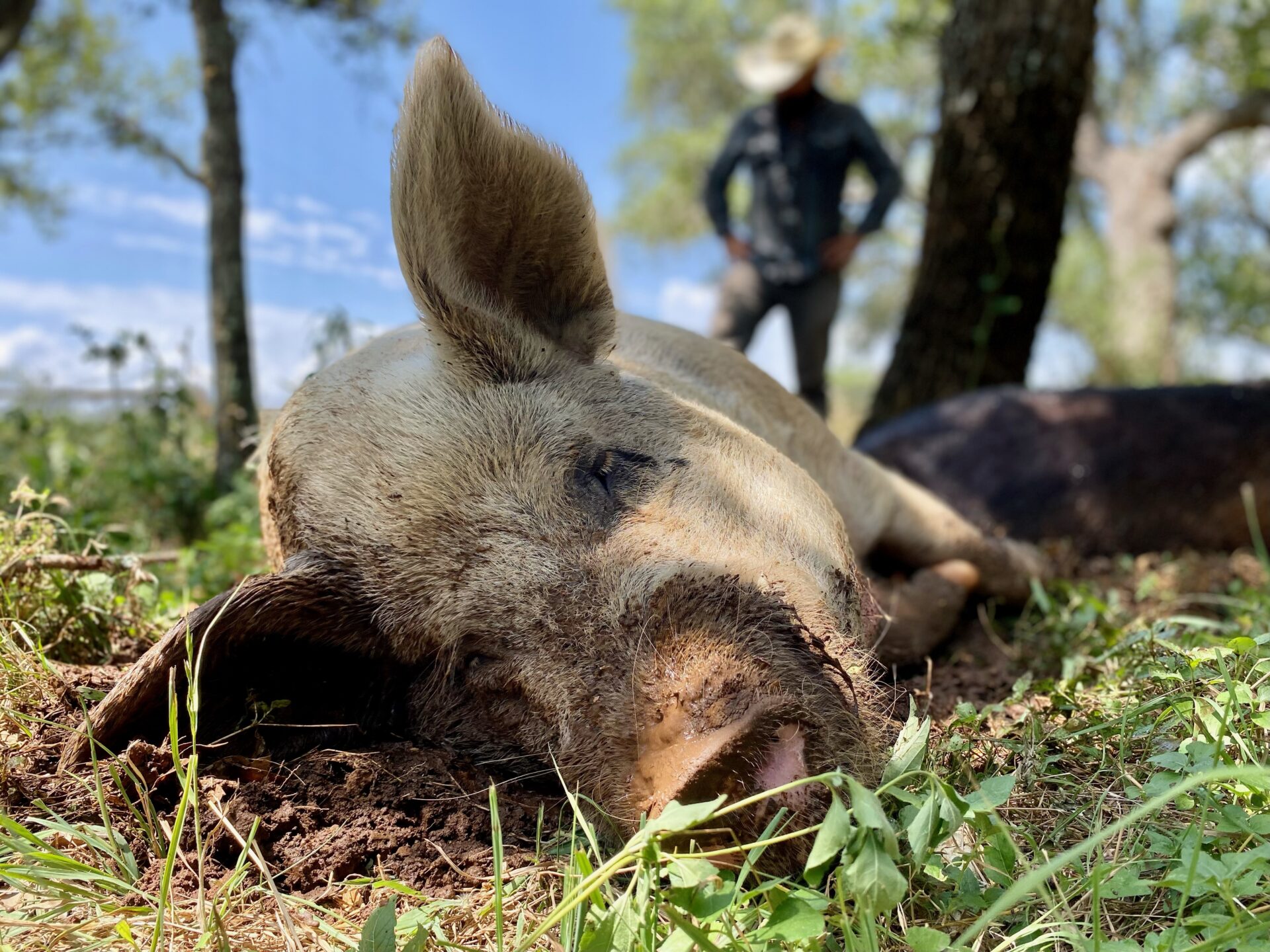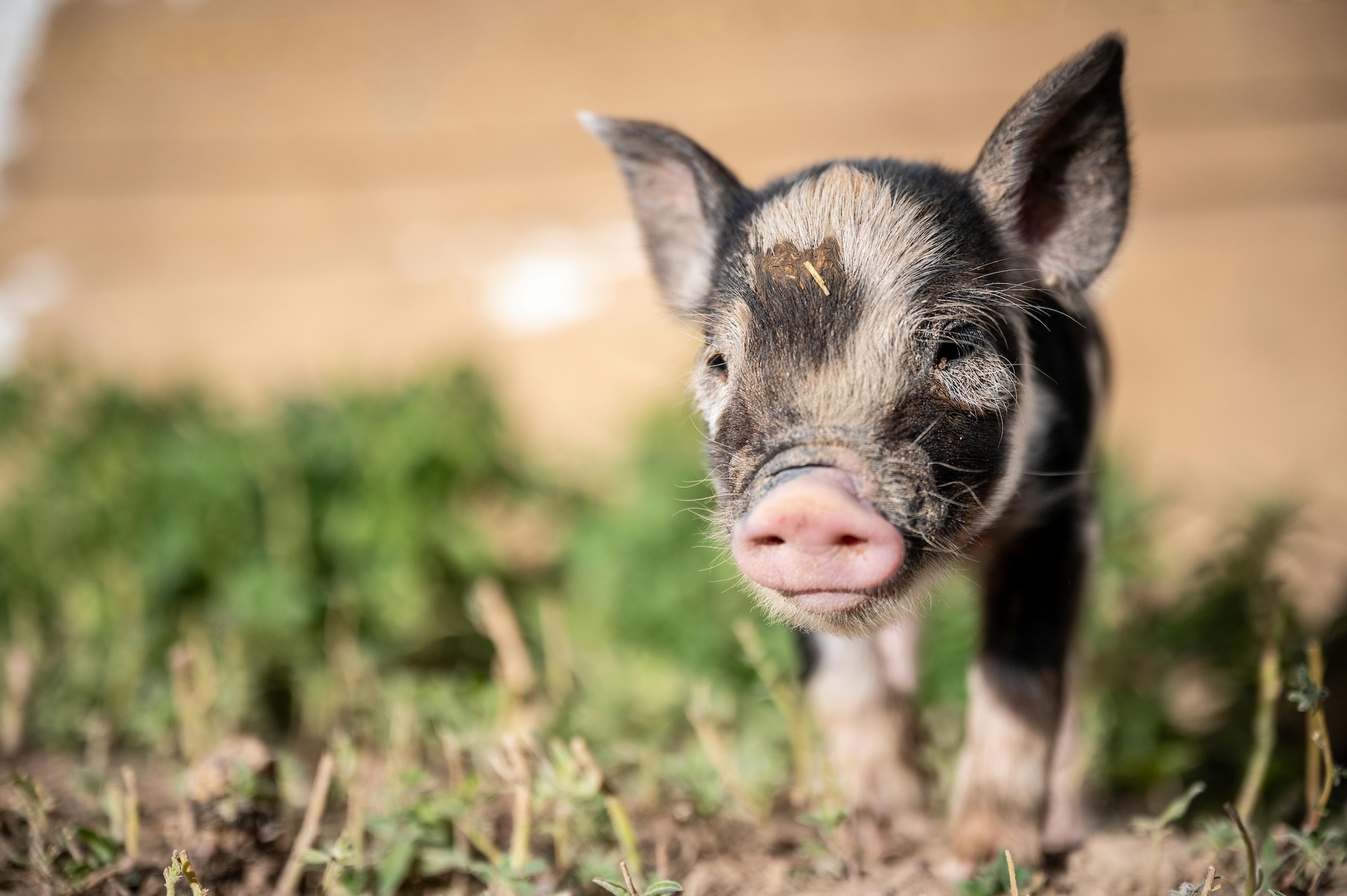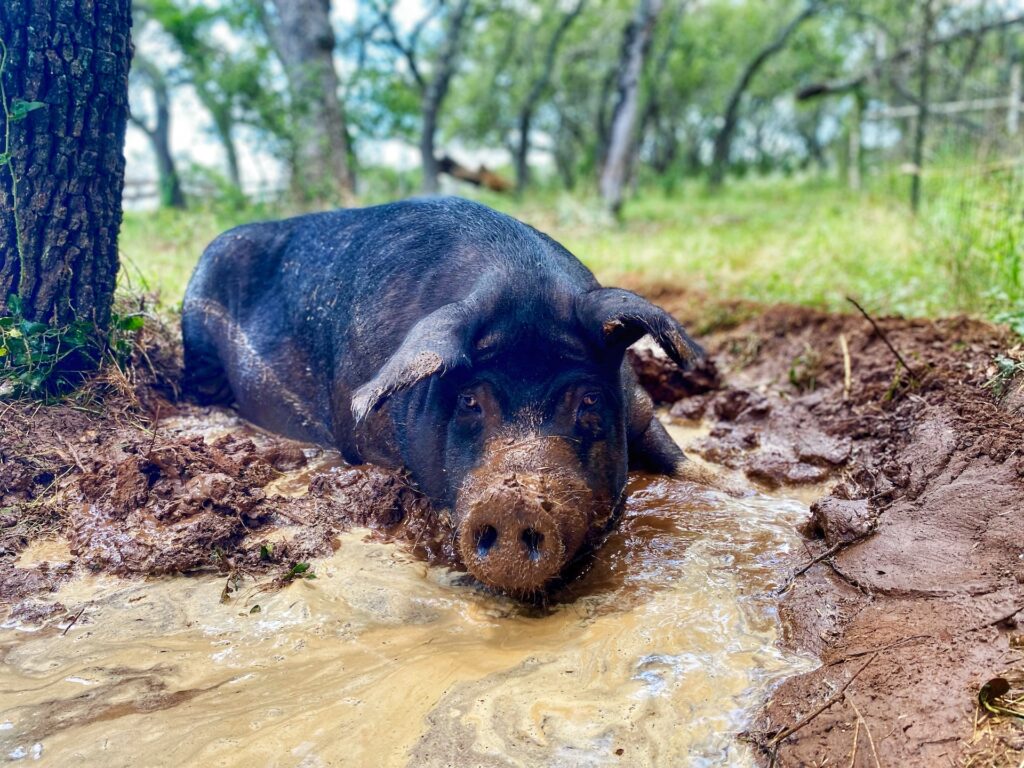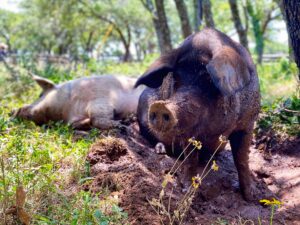Pigs have a natural inclination to wallow, particularly in hot weather, to cool down and protect their skin from the sun. But when it comes to raising pigs on pasture or using paddock rotation systems, the question often arises: do pigs really need a wallow? The answer is yes, wallows are imperative for pigs, but managing them effectively requires careful planning and strategies to maintain both the pigs’ well-being and the land’s integrity.
Why Do Pigs Need a Wallow?
Cooling Mechanism
Pigs do not sweat like humans, so they rely on external methods to regulate their body temperature. Wallowing in mud or water helps them cool down on hot days. For pigs, consider weather above 75°F, especially in areas with higher humidity, to be a ‘hot day.’ This natural behavior is essential for preventing heat stress, which can lead to serious health issues if not managed properly.
Without the ability to sweat, pigs are more susceptible to overheating, making wallowing crucial for their survival in hot climates. The mud evaporates slowly, providing a prolonged cooling effect as it dries. In addition to wallowing, pigs will often seek out shade and cool surfaces to lie on, further helping to regulate their body temperature. Proper management of wallowing areas is vital to ensure pigs remain comfortable and healthy during the warmer months.
A HOT PIG IS A DEAD PIG.
Skin Protection
The mud from wallows provides a protective layer against sunburn and insect bites. It can also help keep their skin moist and reduce the risk of skin conditions such as dry, cracked skin, dermatitis, and sunburn. Dry and cracked skin can become painful and lead to infections if not properly managed. Dermatitis, often caused by parasitic infestations or bacterial infections, can be alleviated by the soothing and cleansing properties of mud. Sunburn is another significant concern, especially for pigs with lighter skin, and the mud acts as a natural sunscreen, protecting their sensitive skin from powerful UV rays. By wallowing, pigs create a protective barrier that helps prevent these skin issues, promoting overall skin health.
Behavioral Enrichment
Wallowing offers behavioral enrichment, allowing pigs to engage in their instinctual activities, which promotes overall well-being. This natural activity not only keeps pigs physically healthy but also mentally stimulated, reducing the likelihood of stress-related behaviors such as aggression or excessive vocalization. By facilitating wallowing, ranchers can ensure their pigs lead happier, more contented lives.

Wallow Management in Pastured Pigs
Managing wallows for pastured pigs involves creating and maintaining wallow areas that allow pigs to cool off without causing excessive soil damage or creating unsightly holes across your pasture.
If you don’t set up a wallow, trust us, the pigs will take matters into their own hooves. Get ahead of the game and plan out your wallow management before they turn your pasture into their own personal mud spa. By designing and managing the wallow areas, you can ensure they are in the best locations for both your pigs and your land.
Designate Wallow Areas
Set up designated wallow zones in each pasture area. Choose spots that are easy to manage and away from sensitive areas like water sources or slopes. When setting up wallow zones for pigs, it’s crucial to choose the right locations to ensure the well-being of your livestock and the health of your land. Here are some key factors to consider:
Traffic Patterns
Good Area: Choose areas that are not heavily trafficked by humans or other livestock to avoid excessive disturbance and soil compaction. Pigs need a peaceful space to wallow without constant disruptions.
Bad Area: Avoid areas near gates, feeding stations, or common pathways where frequent traffic could disrupt the wallow and stress the pigs.
Sunlight vs. Shade
Good Area: Select spots with partial shade. Shade is essential to prevent the water in the wallow from heating up too much and to provide a cool environment for the pigs. Trees or shade structures can offer relief from the sun.
Bad Area: Avoid completely shaded areas as these might not dry out between uses, leading to stagnant water which can attract pests and promote bacterial growth. Similarly, avoid fully sun-exposed areas where the wallow can quickly become too warm.
Topographic Changes
Good Area: Opt for flat or gently sloping areas where water can naturally collect without causing erosion. These areas are easier to manage and maintain.
Bad Area: Steer clear of steep slopes or hilly terrain where water might run off quickly or cause soil erosion. Avoid low-lying areas prone to flooding, which can become overly saturated and difficult to manage.
Soil Type
Good Area: Select areas with clay or loam soil that can hold water effectively, creating a durable and consistent wallow. These soil types help maintain the wallow structure.
Bad Area: Avoid sandy or rocky soils that drain too quickly or are difficult to shape into a wallow. These types of soil won’t retain water well, making it hard to maintain a functional wallow.
Proximity to Water Sources
Good Area: Place wallows at a moderate distance from water sources to make it convenient to fill them but far enough to prevent contamination and excessive soil moisture around the water source.
Bad Area: Avoid setting up wallows right next to water sources or on slopes leading to water bodies, as this can lead to contamination and erosion issues.
Access and Maintenance
Good Area: Choose accessible areas where you can easily fill the wallow with water and perform regular maintenance. Ensure that these areas can be monitored and managed without much difficulty.
Bad Area: Avoid remote or hard-to-reach areas where maintaining the wallow and monitoring the pigs’ health could be challenging.
Portable Wallow Solutions
Some ranchers use portable wallow tubs or kiddie pools that can be moved as pigs rotate through different pastures. This prevents permanent mud pits and allows you to control where wallows are located. Honestly, we can’t imagine this being an acceptable solution for our 250 lb pigs. While it may be okay for smaller pigs, we just don’t know of any product in a size or material that makes sustainable sense. And if you’re using a portable wallow tub, then you’re also limiting the availability of mud which is an important factor for pig cooling and health.
Practical Steps for Creating and Managing Wallow Areas
Step-by-Step Guide to Setting Up an Ideal Wallow Area
1. Identify Potential Wallow Areas
Survey your pasture to identify potential wallow spots based on the above criteria. Look for flat or gently sloping areas with partial shade and suitable soil types.
2. Test Soil and Drainage
Ensure the selected area has soil that can retain water effectively. Perform a simple test by digging a small hole, filling it with water, and observing how long it takes to drain.
3: Designate Managed Wallow Zones
In each paddock, identify areas where pigs are likely to create wallows. Choose spots that are easy to manage and away from sensitive areas.
Designate the specific wallow zones within each paddock and fortify them with materials like gravel or wood chips to manage mud and prevent soil erosion. These materials also break down over time, adding organic matter to the soil.
4. Create Shade
If natural shade is insufficient, consider installing shade structures such as tarps or shade cloths. This helps maintain a cooler environment for the wallow.
5. Install Controlled Water Systems
Set up a convenient water source, such as a hose and spigot, or a portable water tank, to fill the wallow easily. Ensure it’s close enough for convenience but far enough to avoid contamination. Here’s a few options for you to consider:
Automated Watering System
Setup: Install an automated watering system with a timer to control the flow of water to the wallow. This can be connected to a hose and spigot or a portable water tank with a pump. Automated systems can be set to refill the wallow at specific times, ensuring a consistent supply of fresh water without manual intervention. This is what we and our friends over at Three Sisters Ranch use. Add a sprinkler to the automates system for the best effect.
Gravity-Fed Watering System
Setup: Use a gravity-fed watering system by placing a large water tank on an elevated platform. Connect a hose with a float valve to control the water flow into the wallow. As pigs use the wallow and the water level drops, the float valve will automatically release more water, keeping the wallow filled. This only works if you are using a portable wallow solution.
Solar-Powered Pump System
Setup: For off-grid solutions, install a solar-powered water pump to draw water from a nearby source, such as a pond or well, to fill the wallow. Connect the pump to a hose and set up a timer or float valve system to automate the process. Solar-powered systems are sustainable and reduce dependency on external power sources.
Manual Fill System
Setup: If you’re just getting started and need a quick solution, set up a manual fill system with a drinking water safe hose and spigot. Ensure the water source is close enough for convenience but far enough to avoid contamination. Designate a time each day to refill the wallow, ensuring it remains functional and clean. On hot days, check the wallow twice per day.
6. Regular Maintenance
Regularly check the wallow to ensure it remains functional and clean. Remove debris, replenish water as needed, and monitor the pigs’ use of the wallow to make any necessary adjustments.
By carefully selecting and maintaining your wallow areas, you can create an optimal environment for your pigs to cool off, stay healthy, and enjoy their natural behaviors without compromising the integrity of your land. This proactive approach ensures the well-being of your pigs and the sustainability of your farming practices.
7: Rotate Paddocks Regularly
Rotate pigs through different paddocks every 2-4 weeks. Ensure each new paddock has a designated wallow area and move portable wallows accordingly. When using a paddock rotation system, managing wallows becomes crucial to maintain the health of the land and prevent soil degradation.
8: Apply Mulch and Plant Cover Crops
After moving pigs out of a paddock, apply mulch or wood chips to wallow areas to manage mud. Plant fast-growing cover crops to quickly restore vegetation and improve soil health.

Wallow Adjustments and Considerations for Piglets
When piglets arrive, it’s essential to make specific adjustments and considerations to your wallow setup to ensure their safety and well-being. Piglets have different needs than adult pigs, and careful planning can help create a suitable environment for them. Here are some key adjustments and considerations:
Safety and Accessibility
Shallow Wallows: Create shallower wallows specifically for piglets. Deep wallows can pose a drowning risk, so ensure that the wallow depth is appropriate for their small size.
Gentle Slopes: Design wallows with gentle slopes to allow piglets to enter and exit easily. Steep edges can be difficult for piglets to navigate and increase the risk of injury.
Separate Areas: If possible, create separate wallow areas for piglets and adult pigs. This ensures that the larger pigs do not accidentally harm the smaller piglets. This can be done by using portable wallow solutions or by using a temporary fencing or partitions within the wallow area to create a safer section for piglets. These partitions can be removed or adjusted as piglets grow.
If separate areas is not feasible, you could create a large wallow with varying depths (e.g., 6-12 inches deep in the center for adults and 2-4 inches along the edges for piglets).
Controlled Temperature
Shaded Wallows: Ensure that the wallow area for piglets has ample shade to prevent overheating. Young piglets are particularly vulnerable to extreme temperatures.
Cool Water: Monitor the temperature of the wallow water. During hot weather, ensure that the water remains cool to provide effective cooling for the piglets.
Hygiene and Cleanliness
Regular Cleaning: Clean the wallow frequently to prevent the buildup of bacteria and parasites. Piglets have developing immune systems and are more susceptible to infections.
Fresh Water: Replenish the water in the wallow regularly to maintain cleanliness and hygiene. Avoid stagnant water, which can harbor harmful pathogens.
Monitoring and Supervision
Frequent Checks: Regularly check on the piglets while they are using the wallow. Supervision helps ensure their safety and allows you to intervene if any issues arise.
Observation: Observe piglet behavior in the wallow. If they appear distressed or struggle to use the wallow, make necessary adjustments to improve accessibility and safety.
Location and Setup
Proximity to Shelter: Position the wallow close to the shelter to provide piglets with easy access to shade and protection from the elements.
Soft Ground: Ensure that the ground around the wallow is soft and free from sharp objects or stones that could harm the piglets’ sensitive skin and hooves.
Gradual Introduction
Slow Introduction: Introduce piglets to the wallow gradually. Allow them to explore and get used to the wallow at their own pace, ensuring they feel safe and comfortable.
Mother’s Guidance: Piglets often learn by following their mother’s behavior. Allow the sow to lead the piglets to the wallow and demonstrate how to use it safely.
Practical Steps for Adjusting Wallows for Piglets
1. Create Shallow Wallows
Dig a shallow wallow specifically for piglets, ensuring the depth is safe and manageable for their size. Aim for a depth of 2-3 inches to start.
2. Install Gentle Slopes
Shape the edges of the wallow with gentle slopes to allow easy entry and exit for piglets. Use a shovel or rake to smooth out any steep areas.
3. Provide Shade
Set up shade structures, such as tarps or shade cloths, over the wallow area. If natural shade is available, position the wallow accordingly.
4. Regularly Refresh Water
Ensure the wallow water is changed regularly to maintain hygiene. Use a hose or portable water tank to refill the wallow with fresh, cool water.
5. Monitor and Clean
Check the wallow multiple times a day to ensure it remains safe and clean. Remove any debris or contaminants immediately.
6. Observe Piglet Behavior
Watch how piglets interact with the wallow. Make adjustments as needed based on their behavior and comfort level.
By making these adjustments and considerations, you can create a safe and comfortable wallowing environment for piglets. Ensuring their well-being from a young age sets the foundation for healthy, happy pigs as they grow. This attention to detail and care is essential for maintaining a thriving pig farming operation.
So, Do Pigs Need a Wallow?
Yes, pigs do need a wallow, especially in hot climates where they need to cool off and protect their skin. Effective wallow management is crucial for maintaining the health and well-being of your pigs while preserving the integrity of your pastures. By using designated wallow areas and thoughtful paddock rotation, you can provide your pigs with the benefits of wallowing without causing undue stress to your land. With careful planning and the right tools, you can ensure a harmonious balance between the needs of your pigs and the sustainability of your farm or ranch.

